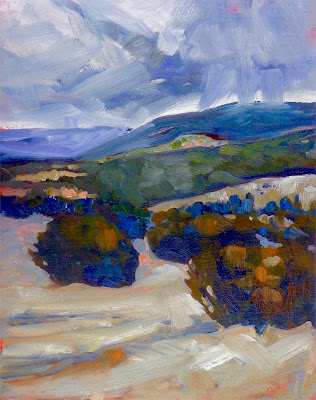I understand and empathize with defensiveness very well, but I also know that it is paralyzing.
 |
| Annett Sauve lets me demonstrate on her canvas. (Photo courtesy of Jane Chapin) |
Thomas Edison is credited with saying that “Genius is one percent inspiration and ninety-nine percent perspiration.” He ought to have added persistence in that equation. It’s a kind of intelligence, one that isn’t measured on tests and used as a predictor of success—but it ought to be.
Of the six students in this workshop, two are returning students. They share that trait of persistence. For both of them, the process of painting has really clicked on this trip. I refine my teaching method with every class, which I think makes it clearer, but the difference is mostly in them.
 |
| Mary Whitney’s painting in paradise. |
Painting is not simple. Learning it takes time, and is a two-way dialogue. The student must be open to what’s being taught in order to make any real progress. Likewise, the teacher must be listening constantly for cues from the student.
For a long time, I was a very defensive painting (and everything else) student. I knew what I thought I knew and wasn’t willing to let others change that, even as I understood I needed help. It was a pity, because it blunted any possibility of becoming a better painter.
What were the symptoms of this self-defeating viewpoint? Whenever a teacher suggested I try something a different way, I responded with a rationalization. “I know, but…” saved me from having to try and fail. I was unnecessarily critical of others’ work, and there was a very limited range of paintings I understood enough to love.
| Karla King and me, working at Pecos National Historic Park. (Photo courtesy of Jane Chapin) |
What cured that? My broken self-image was repaired. To explain how I was broken would require delving into a maelstrom, so I will skip it. But the cure was a combination of my developing faith (I was made in God’s image, so I can’t be fatally flawed) and the slow development of real competence. This was not just as a painter, but as a parent, a spouse, and a functioning adult.
I understand and empathize with defensiveness very well, but I also know that it is paralyzing. I can’t fix it by simply saying, “let down your defenses.” That insecurity is the very nut the student is trying so hard to protect.
Instead, I sidestep the whole question by insisting that, for one week, workshop students try it my way. It’s not arrogance on my part, but rather the desire that students get value for the money they’re shelling out.
 |
| Historic New Mexico. |
I’m thinking about this because I’m going to do a free cocktail-hour webinar on October 2, where I’ll talk about objectives in studying painting. Everyone is welcome, and I hope you bring lots of questions.






























